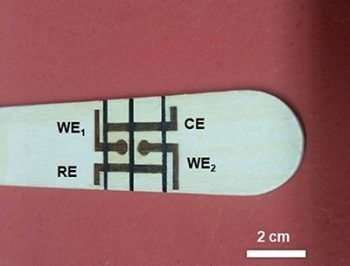Doctors often use tongue depressors when peering in a patient’s mouth and throat. But what if that flat wooden spatula could actively evaluate the patient’s health? That’s the premise of an ecofriendly disposable sensor, reported in ACS’ Analytical Chemistry, that can check levels of glucose and other biomarkers in saliva. Researchers say the easy-to-produce device could someday help doctors assess a range of conditions.
 Electrochemical cells etched by a laser on a wooden tongue depressor can measure glucose and nitrite levels in saliva. (WE = working electrode, CE = common counter electrode, RE = common reference electrode). Adapted from Analytical Chemistry, 2023, DOI: 10.1021/acs.analchem.3c01211. Image Credit: The American Chemical Society (ACS)
Electrochemical cells etched by a laser on a wooden tongue depressor can measure glucose and nitrite levels in saliva. (WE = working electrode, CE = common counter electrode, RE = common reference electrode). Adapted from Analytical Chemistry, 2023, DOI: 10.1021/acs.analchem.3c01211. Image Credit: The American Chemical Society (ACS)
Wood is a renewable, biodegradable, natural material that is widely available at low cost, which makes it attractive for researchers who design electronics and sensors. However, this is challenging because the material isn’t good at conducting electricity. One solution is to use wood as a passive substrate and then coat it with metals and carbon-based inks. Alternatively, high-power lasers can char specific regions on the wood, turning those spots into conductive graphite. But this complicated technique requires sophisticated and expensive instrumentation, an oxygen-free atmosphere and fire retardants. To develop a cheaper and easier process, Christos Kokkinos and colleagues turned to low-power diode lasers, which have already been successfully used to make polyimide-based sensors but haven’t previously been applied to wooden electronics and electrochemical sensors.
The team used a portable, low-cost laser engraver to create a pattern of conductive graphite electrodes on a wooden tongue depressor, without the need for special conditions. Those electrodes formed two electrochemical cells separated by lines drawn with a water-repellent permanent marker. The biosensor was then used to rapidly and simultaneously measure concentrations of nitrite and glucose in artificial saliva. Nitrite can reveal oral diseases, such as periodontitis, while glucose can serve as a diagnostic for diabetes. The researchers say these low-cost devices could be adapted to detect other saliva biomarkers and would be quick and easy to produce on-site at medical facilities.
The researchers did not receive outside funding for the study.